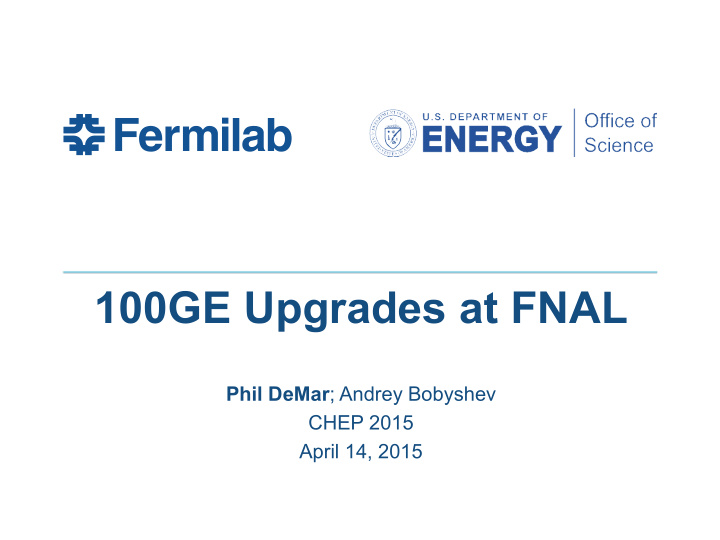



100GE Upgrades at FNAL Phil DeMar ; Andrey Bobyshev CHEP 2015 April 14, 2015
FNAL High-Impact Traffic Isolation Philosophy • If feasible, science data traffic kept logically separate: – Optimal performance likely over WAN science data network paths – Easier to target internal LAN upgrades on high-impact science needs – May facilitate more flexible perimeter security models – More limited interaction with sensitive or interactive traffic: • Don’t want this to be your users audio/video applications • Routed IP network path still supports our general internet traffic – Also a significant percentage of our science data traffic as well 2 Phil DeMar - CHEP 2015 4/14/2015
FNAL’s Science Data WAN Network Paths • LHCOPN: – T0 <-> T1 data – (Most T1 <-> T1 data movement – Supported by three virtual circuits: • Primary – 40Gb/s guaranteed • Secondary – 30Gb/s (failover) • Tertiary – 10Gb/s (failover II) • LHCONE (Obligatory LHCOPN figure) – Private routed virtual network – FNAL LHCONE traffic via ESnet, including trans-Atlantic stuff – US LHC universities starting to migrate to ESnet for LHCONE • Legacy pt-to-pt virtual circuits (static) – Six US Tier-2s have circuits to FNAL 3 Phil DeMar - CHEP 2015 4/14/2015
Current Perimeter Architecture • Science data network services supported with separate infrastructure: – Separate border router – Bypass path(s) – Security model: Known Traffic from well-known systems at trusted sites • General routed internet traffic via primary border router: – Fails over to secondary (not load-balanced...) – Some science data via routed IP 4 Phil DeMar - CHEP 2015 4/14/2015
How Science Network Traffic Is Isolated • Keyed on Policy-Based Routing (PBR) – Essentially source/destination ACLs • Satisfies security policy for bypass traffic – Ingress on science data network border router – Egress for bypass from data center LANs (ie., CMS Tier-1) • Object tracking & SLA monitoring check that PBR path is functional • Science network non- PBR traffic forwarded to routed IP path – May create path asymmetry issues 5 Phil DeMar - CHEP 2015 4/14/2015
Now On To 100GE Upgrades 6 Phil DeMar | FNAL Site Report 10/30/2014
FNAL WAN Access – ChiExpress MAN • ChiExpress: – ESnet local loop access for FNAL (and neighboring ANL) – 100GE-based technology – Full geographic redundancy – Reasonable channel reconfiguration (~1hr) • FNAL channels: – One 100GE – 2 nd 100GE in place but not in use yet – Four 10GE channels • Routed IP • Backup science data path 7 Phil DeMar - CHEP 2015 4/14/2015
New Perimeter Architecture • Consolidation to two border devices: – Cost-driven – Based on Brocade MLXe’s – In progress: • 4-6 month cutover • Science traffic still kept logically separate • Routed IP traffic still based on default & failover • Network R&D becoming a high-impact traffic factor 8 Phil DeMar - CHEP 2015 4/14/2015
WAN Traffic Distribution Strategy • One 100GE channel for production science data traffic – Circuits (including LHCOPN) and LHCONE traffic… • Second 100GE for network research & failover of science data traffic (LHCONE) – Will reexamine/readjust this strategy when science data traffic starts pushing up toward 100GE: • Optimally, just upgrade that channel to 2x100GE • Or load-balance LHCONE traffic across existing 100GE channels – Generally, circuit-based traffic falls back on routed IP path • Migrating routed IP traffic over to 100GE channel(s) is a goal – Starting to saturate current 2x10GE capacity – Support for >10GE flows – But no specific time table yet 9 Phil DeMar - CHEP 2015 4/14/2015
VRFs • Separation of science data & general IP network routing done by virtual routing & forwarding (VRF) technology: – Shared layer-2 (SVIs) – Separate layer-3 Primary – Preserves current border router security model • Current implementation problem: • Only default MLXe VRF Secondary has PBR capability border router • Looking into work-arounds 10 Phil DeMar - CHEP 2015 4/14/2015
100GE In the Data Centers 11 Phil DeMar | FNAL Site Report 10/30/2014
100GE Upgrades – CMS Tier-1 • Interconnect between dual core Nexus 7000’s upgraded to 2x100GE: – Replaces 16 x 10GE – Addtl 100GE links to aggregation switches • WAN connection upgraded to 100GE • Replaces 4 x 10GE • Wide-scale 10GB-T deployment • ~200 systems this year • EOR/MOR, not TOR 12 Phil DeMar - CHEP 2015 4/14/2015
100GE Upgrades – General Data Center(s) • Interconnect between dual core Nexus 7710’s upgraded to 100GE: – Replaces 8 x 10GE – 100GE link to one aggregation switch as well • WAN connection upgraded to 100GE • Replaces 2 x 10GE • 10GB-T deployment scaling up • ~50 systems this year 13 Phil DeMar - CHEP 2015 4/14/2015
Resiliency • 100GE MAN channel up: • LHCOPN & LHCONE follow usual paths • No PBR changes • 100GE MAN channel down: • LHC tertiary & LHCONE thru other 100GE • No PBR changes • Primary border rtr down: • LHC tertiary & LHCONE thru other LAN path • PBR multihop tracking reroutes to backup bypass 4/14/2015 14 Phil DeMar - CHEP 2015
Future Directions • Immediate term – finish consolidation into two border devices • Short term – consolidate science data network traffic: – Migrate T1 <->T1 traffic over to LHCONE – Phase out legacy static circuits in favor of LHCONE: • Obviously requires coordinated actions with remote sites • Long term – evaluate SDN-based technologies (OpenFlow) to isolate on-site science data traffic – Evolution of inter-domain SDN is too unclear now to start planning SDN beyond our border 15 Phil DeMar | FNAL Site Report 10/30/2014
Questions? 16 Phil DeMar | FNAL Site Report 10/30/2014
Recommend
More recommend